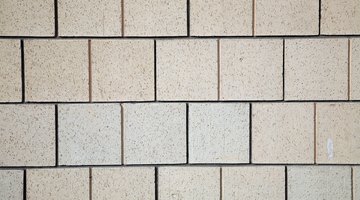How to Build a Cinder Block Wall With a Curve
Cinder blocks can be used to build a variety of wall structures, ranging from foundations for homes to retaining walls used in gardens and patios. The overall process of building blocks walls is the same regardless if you are building a straight wall or a curved wall.

The only real difference involves whether or not the wall is structural or simply a retaining wall. All structural walls require the help of a structural engineer, but any nonstructural cinder block wall can be finished on your own with nothing more than basic carpentry skills and knowledge.
Things You Will Need
- Garden hose
- Safety glasses
- Work gloves
- Dust mask
- Shovel
- Wheelbarrow
- Concrete mix
- Mason trowel
- Level
- Rubber mallet
- Angle grinder with stone blade
- Radius blocks
-
Outline the borders of your wall with a garden hose to help you dig the footer area. All block walls require a footer to help spread the weight of the wall over the ground so they don’t sink into the soil. The footer should be twice as wide as the thickness of the wall and should be deep enough to go below the frost line, which is around 8 to 10 inches deep. Dig down with a shovel to clear the footer area.
-
Remove the garden hose and mix up some mortar in your wheelbarrow with the shovel. Follow the directions on the bag (differently sized bags have different water requirements and vary depending on the manufacturer), dump the mortar into the trench and let it harden to create the footer.
-
Mix up some more of the mortar mix on the following day and use this for your block wall. Shove an inch or so of the mud onto the top of the footer and set your first row of blocks along the radius of your curved footer. Center the blocks on top of your footer. Allow one-half inch between each block for mortar. Tap them together with the mallet and use the level to guide you as you tamp the blocks down into the base layer of mortar.
-
Add another row of blocks on top of the first, with another three-quarters to 1 inch of mortar laid on top of the first row of blocks. Alternate the blocks so that the vertical joints do not line up. Tamp them in place with the mallet and repeat the process for each subsequent row. Check the wall for plumb with your level every three or four rows and adjust as necessary.
Tip
Select radius blocks, rather than square blocks, for the best results. If your wall goes over 4 feet in height, consult with a structural engineer about support structures for the wall. Anything under 4 feet you can build on your own without worrying about structural support. Make cuts with the angle grinder.
Warning
Wear safety gear when working with concrete and power tools. Do not allow raw concrete to touch your skin, as the chemicals will cause instant burns.
The Drip Cap
- Cinder blocks can be used to build a variety of wall structures, ranging from foundations for homes to retaining walls used in gardens and patios.
- Follow the directions on the bag (differently sized bags have different water requirements and vary depending on the manufacturer), dump the mortar into the trench and let it harden to create the footer.
- Allow one-half inch between each block for mortar.
- Tap them together with the mallet and use the level to guide you as you tamp the blocks down into the base layer of mortar.
Resources
Writer Bio
Tim Anderson has been freelance writing since 2007. His has been published online through GTV Magazine, Home Anatomy, TravBuddy, MMO Hub, Killer Guides and the Delegate2 group. He spent more than 15 years as a third-generation tile and stone contractor before transitioning into freelance writing.
Photo Credits
- Jupiterimages/Photos.com/Getty Images
- Jupiterimages/Photos.com/Getty Images
More Articles
- How to Build a Circular Flower Bed With a Stone Retaining Wall
- How to Build a Stone Wall With Round Stones & Cement
- How to Attach Roof Trusses to the Top of a Block Wall
- How to Install a Capstone on a Retaining Wall
- How to Install a Paver Stone Retaining Wall
- How to Build a Brick Wall on Uneven Ground



